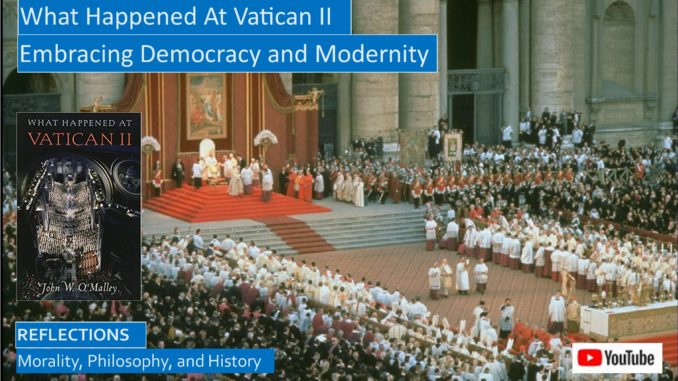
Pope Benedict once said that both the supporters and opponents of the Second Vatican Council have one characteristic in common, and that is, most of them have never read the decrees or the history of Vatican II and are ignorant of the actual teachings of the council. His solution was to draft the Catholic Catechism, but unfortunately, nobody reads that either.
A priest once compared Vatican II to a Japanese fishing boat. One sunny morning a fisherman and his eight-year-old son went far out to sea to fish. Late in the day the son took a nap, and while he was napping the boat slowly rose and slowly fell through many deep swells like the father had never seen before. Later that day when they tried to return to their village, but there was no village, there was only death, debris, destruction, and dank water as far as the eye could see. The little boy was devastated, the little boy cried in terror, no family, no house, no village, all had pulverized and swept out to sea. But the little boy did not find fault with sea, as he was sleeping during the swells of the tsunami, the little boy blamed the boat for the catastrophe.
The Catholic Church was experiencing a great historical tsunami in the Sixties when Vatican II met to throw open the windows of the Church to the modern world, as Pope John XXIII, the pope who called the council into session, proclaimed. This was not a council pushed on the church by liberal popes. On the contrary, many bishops from around the world eagerly participated in the Council, this was the exact opposite of a rubber-stamp council. Society and the Church were overwhelmed by the tsunami of changes of the Sixties, changes set in motion by the events of World War II, Vatican II was merely the boat seeking a better place for the church.
So it is with Vatican II. Many conservative Catholics see the permissiveness of the past fifty years, the breakdown in morals, the breakup of the family life, the shortage of priests and vocations, the mocking of the faithful, and they do not blame the vast sea of change sweeping society; but rather, they blame the boat, they blame the Church Fathers of Vatican II who sought clear passage through the difficult waters of the modern world.
This story also illustrates a common misconception of both Trent and Vatican II, that Trent was the true Catholic council, and that Vatican II abandoned the theology of Trent. The opposite is true, the theology of Trent was adopted, with few changes. while the reforms of Vatican II were political, they restated the Catholic faith to the world in a pastoral manner, embracing democracy while discouraging totalitarianism. Gone were the anathemas issued by Trent to the enemies of the church, the church of Vatican II seeks to dialogue with its separated brethren in Christ and indeed, people of all faiths and nations. Vatican II was a rediscovery of the reforming aspects of the Council of Trent; indeed, theologically speaking, it would be more accurate to refer to this council as Trent II.
Video for this blog: https://youtu.be/vHtYu6UtiuE
SlideShare script for this video, © Copyright 2021: https://www.slideshare.net/BruceStrom1/what-happened-at-vatican-ii-embracing-democracy-and-modernity
CATHOLIC CHURCH OPENS IT WINDOWS TO THE MODERN WORLD
The two great wars had swept away the large continental monarchies of Europe that once had supported the Catholic Church, and they were replaced by totalitarian fascist regimes, and though several fascist regimes were friendly to the Catholic Church in the short run, most were hostile or harmful to the Church in the long run. Indeed, Vatican II is unimaginable without the changes wrought by World War II.
For example, the fascist regime of Mussolini was initially the friend of the Catholic Church, though he personally was neither devout nor moral, both a murderer and an adulterer. He signed the Lateran Treaty creating the Vatican City and guaranteed that the Church had an exclusive role in the schools and the culture. But shortly before World War II, he went full Nazi, and started persecuting the Jews.
The fascist regime of Spain was the friend of the Catholic Church, and although both sides in the Spanish Civil War were guilty of massacres, the communists on the Republican side murdered priests and monks and nuns by the thousands.
Once Hitler gained absolute power, the Nazis started persecuting both the Jews and the Protestant and Catholic Churches. The pope and some German bishops opposed the Nazis as best as they could, whereas only twenty percent of the Protestant churches were Confessing Churches that opposed interference from the Nazi regime.
The Catholic conservative Vichy French regime collaborated with the Nazi regime, combining the pro-life, pro-Catholic policies with persecuting the Jews in France.
These bad experiences with totalitarianism meant that the Vatican II Council would embrace democracy, with all its problems, as the system of government most conducive to religious liberty and toleration in the long run. We discuss this in our video on the Decree on Religious Freedom, this is a key video to understand the history of Vatican II.
We plan to record videos/blogs for the other major decrees, with their history and studying the decrees themselves.
Another consequence of World War II was that most former European colonies in Asia and Africa were gaining their independence, some peacefully, some through revolution. Catholics in these countries wanted to run the churches in their countries, and they desired liturgies that reflected their local cultures.
John O’Malley also tells the story of the reforms implemented by the Catholic Church in the Long Nineteenth Century from the defeat of Napoleon to the start of World War I helped prepare the Church for Vatican II, a story we will cover in a separate video.
We will also have a video on how Pope John XXIII came to call the Vatican II Council into session, and the book by Yves Congar on True and False Reform in the Church that so impressed John that he appointed Congar to a key position in the Preparatory Commission that was preparing documents for the Council. These initial documents were sent for comments to all bishops around the world. The Curia occupied key positions on the commission, they expected that the bishops would rubber-stamp their proposal, but this did not happen, the bishops insisted on becoming very involved in the process, rewriting key documents from scratch.
Pope John XXIII wanted the council to be collegial in fact, although he sometimes let it be known what his positions were, he allowed the Council free rein to discuss the matters they were facing in their dioceses, and the issues the church was facing in the modern world.
Although Pope John XXIII’s family had the lineage of an ancient aristocratic family, the family money had been dissipated generations in the past, and now his family were impoverished sharecroppers. He showed promise in his schooling and in his priesthood, and his service as a medic in World War I, he held many unusual posts:
- Apostolic delegate to Turkey and Greece.
- Saved many Jews by his diplomatic efforts during World War II.
- Served as Apostolic Nuncio to secular France after the war, then Cardinal in Venice.
His postings in the Orthodox, Muslim, and the secular world widened his horizons, and led to his calling of the Council.
The Council would meet for four sessions, Pope John XXIII died soon after the closing of the First Session, and Pope Paul VI was elected Pope with his promise he would continue the work of the council. His family upper middle class, he served in the Curia as a priest, and he intervened in the workings of the council more frequently.
FIRST SESSION, FIRST TOPIC ON THE LITURGY, Sacrosanctum Concilium
The first Constitution to be discussed when Vatican II was convened in October 1962, was Sacrosanctum Concilium, in English, “This Sacred Council,” regarding the liturgy of the Mass. The original document from the Preparatory Commission was progressive, in part because the prior Popes Pius XI and Pope Pius XII, who was pope during and after World War II, had themselves worked on liturgical reform. Plus, the new scholarship studying the newly archives of Trent revealed that the actual Trent proceedings indicated that they were open to a Mass in the vernacular languages, but in the polemics of the day, the Latin mass helped define Catholicism against the vernacular Protestants. Likewise, Trent was open to sharing both the bread and the cup in the Eucharist with the laymen, but again, receiving only the host was also seen as something that defined you as Catholic.
There was a consensus in the Council that the pastoral problem was that ordinary Catholics were must spectators rather than active participants in the Mass. Since the Latin Mass was unintelligible to many worshippers, they instead substituted devotions such as praying the Rosary for actual participation. There was also a shift from the Medieval view that Redemption came mainly through Christ’s suffering and death, with a greater emphasis on the Christ’s Easter resurrection.
In contrast, as O’Malley states, there was a shift in spirituality, now the view is that “the liturgy is nourishment for one’s spiritual life,” that is part of the Church’s “call to holiness.” “Intelligibility and simplicity were now the norms,” the new emphasis is that “Christ is present in the Word of Scripture as well as in the Eucharist.” This emphasis on the Word encouraged a new emphasis of “Scripture in Catholic teaching and piety, a major theme in the Council. While the essential structure of the Roman Rite was to be maintained, local adaptation, especially in missionary countries, was legitimate and encouraged.” Thus, “local bishops or episcopal conferences were permitted to make decisions” regarding the liturgy. No doubt the Vatican attendees remembered the collapse of the Jesuit Christian mission in China when the Vatican refused to permit chanting the Mass in the vernacular.
About a year later, Sacrosanctum Concilium was the first constitution to be passed nearly unanimously by the bishops. As O’Malley relates, “The priest, instead of celebrating Mass with his back to the congregation,” “now faced the pews. This change signified that the ceremony was an act of worship of a gathered community as well as a sacrifice to God performed in the congregation’s name.” Although some parts of the Mass could be chanted in Latin, “within a few years the Mass in its entirety was being celebrated in the vernacular worldwide.”
The Liturgy is central to the Christian experience. O’Malley thus views this decision as crucial to the direction of the Council, foretelling the direction of future debates, O’Malley lists four principles key to understanding Vatican II:
- “The principle of aggiornamento, or adaptation to contemporary circumstances.” But this decree also relied on the “principle of ressourcement,” “a return to the ancient sources in order to find their way. The Mass was thus not so much ‘modernized’ as it was made to conform more closely to fundamental and traditional values.”
- “The principle of adaptation to local circumstances.” O’Malley quotes the decree, “The church does not wish to impose a rigid uniformity in matters that do not involve the faith or the good of the whole community,” enabling the church to “step out of its European box.”
- “Principle of episcopal authority and of greater decision-making on the local level” and episcopal collegiality.
- The final principle is encouraging the “full and active participation of everybody present in the liturgy. This is a principle of engagement and active responsibility, and by implication is extends beyond the liturgy to the church at large, to the church as the ‘people of God.’”[1]
FIRST SESSION, DEI VERBUM, ON REVELATION
The Decree of Revelation, Dei Verbum, would not enjoy clear sailing. Although it was eventually passed nearly unanimously, it was passed late in the Fourth Session three years later. The draft proposed by Cardinal Ottaviani of the Curia was overly conservative and not well received, Pope John XXIII intervened to suggest a mixed commission representing both conservative and progressive theologians and bishops to draft a replacement decree.
One key issue was the Reformation debate on whether Scripture or Tradition was the primary source of Christian truth, Luther had declared that “Scripture Alone” contained the Christian message, forcing Catholics to argue for the primacy of Tradition. However, Herbert Jedine’s scholarship on Trent revealed, in O’Malley’s words, “that subsequent Catholic interpretation of Trent’s few words on the subject, used in polemic against Protestants, had gone far beyond what Trent intended to say.”
The progressive council father, Yves Congar, had written a book on the Meaning of Tradition, but he could only go back to years following the Reformation to explore this topic, because theologians simply did not debate this issue before the Reformation, Scripture v. Tradition was a question that neither the ancient Church Fathers, nor the Carolingian or Medieval Church Fathers, discussed.
http://www.seekingvirtueandwisdom.com/yves-congar-meaning-of-tradition-blog-1/ and http://www.seekingvirtueandwisdom.com/yves-congar-meaning-of-tradition-blog-2/ and https://youtu.be/f0gQ_Y9tROo
When Dei Verbum was approved, one distinguished Catholic journal proclaimed, “We now can consider the ear of the Counter-Reformation ended and a new era for Christendom, with unforeseen circumstances, begun.”[2]
ENDING THE FIRST PERIOD
The conservative Cardinal Ottaviani introduced a constitution on the church, De Ecclesia, which sparked deep disagreements when it was being drafted. As O’Malley noted, “the schema was long,” including “chapters on the church militant, on church membership, on the episcopacy, on religious orders, on the laity, on the Magisterium” or teaching office, “on authority and obedience in the church, on church-state relations, and finally on ecumenicism.” In particular, it emphasized that “obedience to ecclesiastical, especially papal, authority was the remedy for the ‘crisis of authority’ in the world that afflicted even some members of the church.”
De Smedt delivered a widely quoted speech that even Yves Congar thought was overly harsh, as O’Malley puts it, “he denounced the schema for its three isms, triumphalism, clericalism, and juridicism. The document has a pompous and romantic style with a ‘triumphalist’ spirit, out of touch with the reality of the humble people of God. Its clericalism” had “everything flowing from top to bottom, ignoring the horizontal relationships in the church. The reality of the People of God is more fundamental than the hierarchy of the church. We must beware of falling into some kind of bishop-worship or pope-worship. And finally, the church is more our mother than a juridical institution.”
Then another bishop pointed out that the footnotes only went back a hundred years, during the time of the Catholic-Protestant polemic war of words, and that there was no support cited by either ancient or medieval Church Fathers. This celebrated the embattled monarchial view of the Counter-Reformation.
Before the council adjourned, Cardinal Suenens, in close consultation with Pope John XXIII, addressed the council and declared that a central theme was needed to give direction to the Council. “The council should emphasize what unites Catholics with others, not what separates them. “He suggested the theme, quoting from the pope, of “the Church of Christ, light to the world,” or Ecclesia Christi, Lumen Gentium, and Lumen Gentium would be the name of the constitution to replace De Ecclesia. As O’Malley states, “the theme has two parts, the first part looks to the inner reality of the church and asks the question, ‘What do you say of yourself?’ The second part concerns the relationship of the church to the world outside it, and asks questions about the human person, about social justice, about evangelization of the poor, about world peace.”
O’Malley continues, “The Council will proceed with three dialogues:
- A dialogue with its own membership.
- An ecumenical dialogue with ‘brothers and sisters not now visibly united with it.’
- And a dialogue ‘with the modern world.’”
Cardinal Suenens, speaking for the pope, “asked that the council adopt that program for its future work. Let us hope that this plan that I propose will open a way for a better hearing of the church and understanding of it by the world today and that Christ will, for the men and women of our times, be ever more the way, the truth, and the light.”
“Powerful applause!” O’Malley applauds. “This intervention did three things:”
- “It moved the council from a scatter-shot approach.”
- “It contributed to the growing consensus that the original texts needed more than touching up.” The bishops were now expected to be active participants in the council.
- “This sowed the seeds” for the drafting of a new distinctive constitution, Gaudium et Specs, The Church in the Modern World.
The Council adjourned the First Session with a Mass celebrated by Pope John XXIII, which was the last time most participants would see the pope, he would be replaced by Pope Paul VI, who pledged to continue the work of the council.[3]
SECOND SESSION
The Second Session began with discussion of the new schema on the Church, Lumen Gentium. The text revised during the recess differed from De Ecclesia, as O’Malley explains, “the chapters on ecumenicism, evangelization, religious life, and church-state relations had to be excised and reassigned to other commissions. The chapters on the Magisterium and ‘obedience and authority’ in the church had disappeared from the schema and from the council altogether.”
O’Malley continues, one obvious change was that “with the exception of the chapter on the hierarchy, it’s style more filled with biblical images and patristic allusions.” “In the final version, Lumen Gentium almost overflows with images of the church and its members which suggest fecundity, dignity, abundance, charism, goodness, safe-haven, welcome, communion, tenderness, and warmth. This style” points to “the call to holiness.” Most significantly is added that statement that “Christ calls every Christian to holiness and provides the grace and other means to accomplish it, regardless of one’s station in life. Christians fulfill the call through Love of God and neighbor in imitation of Christ.” Lumen Gentium refers to the church as a sacrament, which conservatives objected to, since they thought that the classic seven sacraments are the only sacraments.
By far the biggest controversy in Lumen Gentium was the tension between papal authority and collegiality, or the authority of the bishops, individually and in concert. O’Malley spends many pages on the wrangling and appeals to the pope on this issue, but in the end the principal of collegiality was affirmed, as was the authority of the pope.
Lumen Gentium, in the third chapter, teaches the key them of Vatican II that “pastors were instituted in the church not so that they take upon themselves the whole burden of building up the Mystical Body of Christ, but that they might nourish and govern the faithful so everyone would cooperate in accomplishing the common task.” “Reverence and obedience are due to pastors, but equal reverence is due to those in the church impelled by the Spirit, who are often laymen.”
This is what Lumen Gentium says about infallibility: “The people of Christ as a whole are infallible in their faith when that faith represents a consensus. Such infallibility is a charism that of course includes bishops and the pope but does not rest exclusively in them.” Debate would on Lumen Gentium continued in the next session with few changes.
One reform in Lumen Gentium was to reinstate the diaconate in the Church, a lower level of clergy, and permit married men to serve in the diaconate, which was somewhat controversial.[4]
ECUMENICISM, SECOND SESSION ENDS
The widespread support for ecumenicism was, in part, a response to the World War II experience, where both Catholics and Protestants resisted the Nazi regimes of Hitler’s Germany and Vichy France. For example, during the war Yves Congar developed many friendships with Protestants as a French prisoner of war, his was not a unique experience.
Before Vatican II Catholicism was hostile to ecumenicism. O’Malley tells us that during the debates Cardinal Ruffini summarized the “Catholic apologetics in every seminary textbook:
- Christ founded only one church, the Roman Church.
- Faults cannot be attributed to the church but only to its members.
- To leave the church because of its sinful members is itself a sin.
- The one true church fervently hopes for the return of Protestants.
- Dialogue with non-Catholics is good only if done according to the guidelines the Holy See will publish.
Missing from the document on ecumenicism is the call for non-Catholics to return to the Catholic Church. The document laid out some principles on Ecumenicism, that “change of heart and holiness of life, along with public and private prayer for the unity of Christians, should be regarded as the heart of the whole ecumenical movement.” O’Malley adds that “theology should be taught from an ecumenical viewpoint, not polemically.”
This decree on Ecumenicism was held over to the next session, but the cause of ecumenicism was advanced when Pope Paul VI announced that he would go on a pilgrimage to the Holy Land, which was the first time a pope had left Italy voluntarily for over five hundred years. The pope would also visit the Greek Orthodox patriarch Athenagoras, and at the conclusion of the Council they would revoke the joint Catholic-Orthodox excommunications from many centuries previous.[5]
THE THIRD SESSION
What was happening in the world at this time? President Kennedy had been assassinated, then his assassin was assassinated, the Vietnam War was accelerating, and French troops finally let Algeria.
There was debate from a vocal minority who insisted that the principle of collegiality in Lumen Gentium posed a mortal danger to the church, and this vocal minority constantly badgered the pope, but the overwhelming majority voted for collegiality and the final document.
It had only been twenty years since the world learned the full horror of the Nazi concentration camps where millions of Jews had died. The World Council of Churches had urged all churches to condemn anti-Semitism, so originally the council had planned on a short schema On the Jews. This led to fears in the Arab world that the Vatican planned to recognize the state of Israel, leading to violent riots in many Arab cities and Eastern bishops fearing for the safety of Christians in their region, so then it was included in a schema On the Jews and Non-Christians. There was still diplomatic pressure on the Vatican, so Pope Paul VI intervened so the chapters on the Jews would be included in Lumen Gentium.
The problem was that anti-Semitic stances were justified in the past by passages in John that referred to the Jews as enemies of Christ, and the famous verse in Matthew where the mob at Christ’s trial shouted to Pilate, “His blood be upon us and our children.” Nevertheless, when Cardinal Bea addressed the council, he immediately addressed the issue of deicide, whether the Jews were guilty of murdering God. As O’Malley relates the speech, “the leaders of the Jewish Sanhedrin who” condemned Jesus “were only a tiny percentage of the Jewish people. We cannot attribute to a few people what a few leaders perpetrated. And how can we say that even those leaders knowingly committed deicide when Jesus Himself asked the Father to ‘forgive them for they know not what they do?’”
Dei Verbum was discussed, it evaded the historical Scripture-Tradition debate by saying the “God is the source of revelation, not Scripture or Tradition as such.” “The schema innovated by presenting Tradition in a more dynamic way, as in a symbiotic relationship to Scripture and as the vital principle in the church of the transmission and interpretation of what God had revealed.” “Moreover, Tradition ‘progresses’ over time, as understanding increases with reflection and experience.”
There was also discussion on what would become Gaudium et Spes, the Constitution of the Church in the Modern World. Human dignity is a major theme, including the dignity of human labor and the dignity of the family. O’Malley notes that “running through the text were themes of human solidarity across ethnic, racial, religious, and socioeconomic differences and of the obligation of all peoples to work together for a safer and more just world.”
The chapter on the Dignity of Marriage and the Family departed from the traditional textbook terms of the primary ends of marriage, the procreation of children, and the secondary ends of marriage, which “remedies concupiscence and the mutual help of the spouses.” As O’Malley states, “the document instead spoke at length about the holiness and goodness of the love that bound the spouses; only then did it mention children as the fulfillment of that love. Second, it made the consciences of the spouses the deciding factor for the number of children they should bear.” These were themes that Pope John Paul II would adopt in his teachings on the Theology of the Body. “Finally, the schema did not explicitly reaffirm a condemnation of birth control.”[6]
FOURTH SESSION
The decree On the Jews and the Non-Christian Religions was now named Nostra Aetate, or “In Our Times,” which was the first line of the text. As O’Malley puts it, “instead of beginning with the Jews, it began with the common origin and destiny of humanity.” Then it discussed Hinduism and Buddhism, followed by a long section on Muslims, and discussed Jews before the conclusion. But the clause condemning deicide was still causing problems, Arab states thought this had a political agenda, there were riots, and Eastern bishops were concerned. So, Pope Paul VI intervened to exclude the denial of the guilt of deicide from the text.
Pope Paul VI wanted the council to pass the Decree on Religious Liberty before his planned speech before the United Nations, he did not want to be embarrassed by hundreds of bishops voting against freedom of religion. Was this a contest between bishops of predominantly Catholic countries, who believed the state should enforce religious conformity, versus the minority Catholic countries, including the communist countries, where freedom of religion guaranteed the freedom of Catholics to follow their faith? Indeed, the debate really did break down along those lines.
The speech by the unrelated Joseph Lefebvre helped sway many bishops to support the decree. His argument as summarized by O’Malley:
- “First, the decree would not foster subjectivism and religious indifference;
- Second, it would not mean that the council abdicated the position that the Catholic Church was the only church of Jesus Christ;
- Third, it would not have a bad effect because of the dissemination of error;
- Fourth, it would not diminish missionary spirit;
- Fifth, it does not exalt human beings at God’s expense;
- Sixth, it does not contradict church tradition.”
The vote was taken, and it passed with a ninety percent majority.
Next the Council discussed the very long Gaudium et Spes, On the Church in the Modern World. One challenge was that Pope Paul VI did not want the council to drag out into a fifth session, and Gaudium et Spes was LONG. Unfortunately, the prominent German theologians Karl Rahner and Cardinal Ratzinger, the future Pope Benedict, had misgivings about the text. Fortunately, they were added to the committee modifying the text, which resolved the problem of their opposition. The chapters in Part I are:
- Vocation of the human person.
- The human community.
- The significance of human activity in the world.
- Role of the church in the modern world.
One issue was whether communism should be condemned. Since this had already been done, bishops from communist countries urged caution, fearing this would invite persecution, so no new condemnation was issued.
In the discussions on Part II and political life, they discussed the sections on nuclear arms and warfare. Coincidentally, at this time Pope Paul VI was addressing the United Nations in New York, discussing many of the same topics. In his speech, with deep emotion, he exclaimed, “No more war! War never again! It is peace, peace that must guide the destiny of the people of the world and of all humanity.”
Pope Paul VI also said, “What you proclaim here is the rights and fundamental duties of human beings, their dignity, their liberty, and above all their religious liberty.” Just a few years earlier it would have been unthinkable for a pope to say such things publicly in a speech for the world to hear.
At the Council Ottaviani asserted, “War must be completely outlawed.” In the nuclear age, the prior doctrine of just wars is obsolete. Should they condone stockpiling of nuclear weapons to guarantee peace? The text said yes, few were happy with this assertion.
On the section on marriage, the decree insisted on “the equal personal dignity that must be accorded to man and wife in mutual and unreserved affection.” O’Malley lists many small changes made to the many decrees ratified in this session. In the closing session, attended by Pope Paul VI, “the Joint Declaration of Pope Paul VI and the Orthodox Patriarch Athanagoras was read regretting the excommunication of the Greeks by the Latins and the Latins by the Greeks in 1054, acknowledging the responsibility for both sides for the tragedy, and promising to work toward a full communion between the two churches.” NOTE: The Declaration does not say UNION, but full communion.[7]
SUMMARY, VATICAN II
There were many non-controversial decrees passed with little controversy we did not discuss, we will discuss many in our future videos, especially when they are referenced by the Catholic Catechism, which we will study over the next few years. There was great debate over the four constitutions, which we discussed.
VATICAN II Constitutions
- Lumen gentium (Light of the Nations), Dogmatic Constitution on the Church.
- Dei verbum (Word of God), Dogmatic Constitution on Divine Revelation.
- Sacrosanctum Concilium (This Sacred Council), Constitution on the Sacred Liturgy.
- Gaudium et Spes (Joy and Hope), the Pastoral Constitution on the Church in the Modern World.
In practice there was little difference between the Declarations and Decrees in their effect, the controversial declarations are in bold-face, and these two declarations on religious liberty and practice in some ways are as influential as the constitutions, which is why we discussed the Declaration of Religious Liberty first in its own separate video.
VATICAN II Declarations
- Nostra Aetate (In our time), Declaration on the Relation of the Church with Non-Christian Religions.
- Dignitatis Humanae (Of the Dignity of the Human Person), Declaration on Religious Freedom.
- Gravissimum Educationis (On Education), Declaration on Christian Education.
The decrees and declarations included those on the Eastern Churches, social communication, education and the priesthood.
VAtcan ii Decrees
- Christus Dominus, (Christ the Lord) Decree on the Pastoral Office of Bishops.
- Presbyterorum Ordinis, (Order of Priests) Decree on the Ministry and Life of Priests.
- Optatam Totius, (Desired renewal of the whole church) the Decree on Priestly Training, promulgated by Pope Paul VI on 28 October 1965.
- Perfectæ Caritatis (of Perfect Charity), Decree on the Adaptation and Renewal of Religious Life.
- Apostolicam Actuositatem (Apostolic Activity), Decree on the Apostolate of the Laity.
- Orientalium Ecclesiarum (Of the Eastern Churches), Decree on the Eastern Churches.
- Unitatis Redintegratio (Restoration of unity), Decree on Ecumenism.
- Ad Gentes (To the Nations), Decree on Missionary Activity.
- Inter Mirifica (Among the wonderful), Decree on the Media of Social Communication.
[1] John O’Malley, What Happened at Vatican II Cambridge, The Belknap Press of Harvard University Press, 2008), The First Period, pp. 129-141.
[2] John O’Malley, What Happened at Vatican II, The First Period, pp. 141-151.
[3] John O’Malley, What Happened at Vatican II, The First Period, pp. 152-159.
[4] John O’Malley, What Happened at Vatican II, The Second Period, pp. 173-194.
[5] John O’Malley, What Happened at Vatican II, The Second Period, pp. 194-200.
[6] John O’Malley, What Happened at Vatican II, The Third Period, pp. 206-240.
[7] John O’Malley, What Happened at Vatican II, The Fourth Period, pp. 247-287.

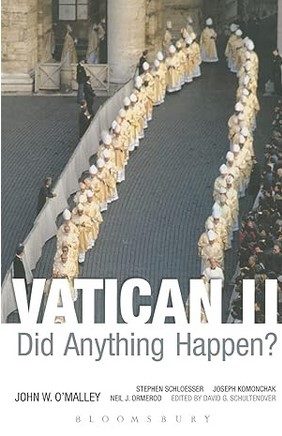
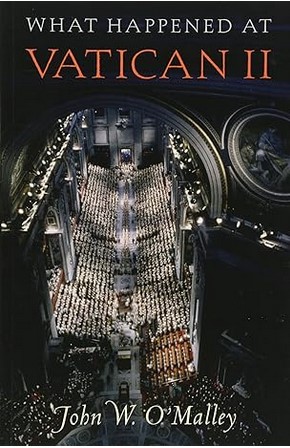
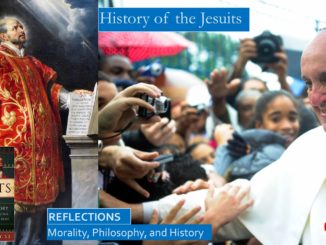
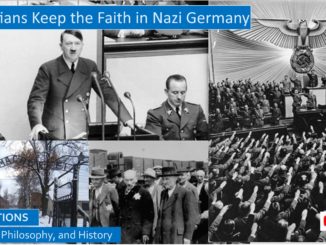
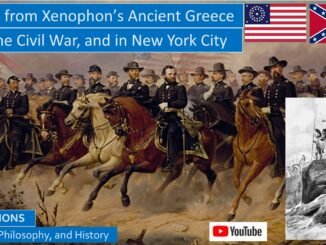
3 Trackbacks / Pingbacks